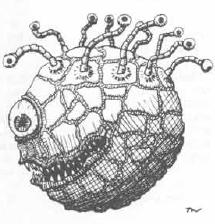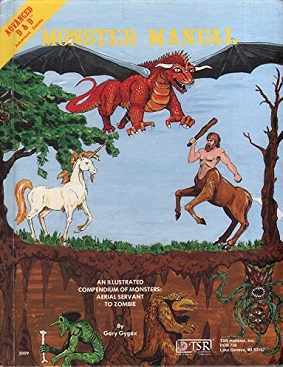
In the Dungeons & Dragons fantasy role-playing game, illithids are monstrous humanoid aberrations with psionic powers. In a typical Dungeons & Dragons campaign setting, they live in the moist caverns and cities of the enormous Underdark. Illithids believe themselves to be the dominant species of the multiverse and use other intelligent creatures as thralls, slaves, and chattel. Illithids are well known for making thralls out of other intelligent creatures, as well as feasting on their brains.

The beholder is a fictional monster in the Dungeons & Dragons fantasy role-playing game. Its appearance is that of a floating orb of flesh with a large mouth, single central eye, and many smaller eyestalks on top with powerful magical abilities.

A displacer beast is a fictional creature from the Dungeons & Dragons role-playing game.

In the Dungeons & Dragons fantasy role-playing game, Doppelgangers are monstrous humanoids, identified primarily by their ability to change their shape and appearance to mimic almost any humanoid creature. They can be used in the game by Dungeon Masters as allies or opponents of the player characters.

In the Dungeons & Dragons fantasy roleplaying game, the otyugh, or gulguthra, is a type of fictional monster. The otyugh was introduced in the first edition Advanced Dungeons & Dragons game's original Monster Manual sourcebook, created by Gary Gygax.

In the Dungeons & Dragons fantasy role-playing game, aboleths are a fictitious race of malevolent, fish-like aberrations with potent psionic abilities. Aboleths are some of the most ancient beings in existence according to Lords of Madness, a Dungeons & Dragons supplement book about creatures classified as "aberrations" such as aboleths, illithids and beholders.
In Dungeons & Dragons, Fey is a category of creatures. The fey deities are associated with the Seelie Court and the Unseelie Court. Titania is the general fey deity, with individual races like the Killmoulis who worship Caoimhin. Fey are usually humanoid in form and generally have supernatural abilities and a connection to nature. The Sylph is one creature which has a Fey appearance, but is officially recognized as an outsider creature type.
In the Dungeons & Dragons fantasy role-playing game, undead is a classification of monsters that can be encountered by player characters. Undead creatures are most often once-living creatures, which have been animated by spiritual or supernatural forces.
In the Dungeons & Dragons fantasy roleplaying game, the choker is an aberration. It can be used by Dungeon Masters as an enemy or ally of the player characters.

In the Dungeons & Dragons fantasy role-playing game, the lamia is a type of fictional monster. The lamia is typically portrayed in the game as a creature with the lower body of a lion, and the upper torso, arms, and head of a human female. A less common type of lamia, the lamia noble, was depicted as having the lower body of a serpent. The lamia was introduced in the first edition Advanced Dungeons & Dragons game's original Monster Manual sourcebook, written by Gary Gygax and published in 1977. The lamia also appeared in second edition and third edition Dungeons & Dragons. In the fourth edition, it was reenvisaged as a swarm of insects. The fifth edition disregards this and returns it to its classic design.

In the Dungeons & Dragons fantasy role-playing game, the roper is a magical beast, resembling a conical structure similar in appearance to rock, wrapped in rope-like tentacles which conceal a mouth. The roper stays very still to resemble a harmless stalagmite, and when prey comes near it lashes out with its tentacled ropes to constrict the prey or pull them back to its mouth.

In the Dungeons & Dragons fantasy role-playing game, the leucrotta is a magical beast.

In the Dungeons & Dragons fantasy roleplaying game, the vargouille is a foul, disgusting, vampiric outsider from evil-aligned planes.

In the Dungeons & Dragons fantasy roleplaying game, the piercer is a type of vermin. It resembles almost exactly a stalactite, only with eyes in the sides. The Piercer is actually a giant gastropod of which the pointy, stalactite-esque part is its shell. Its tail and other such parts can almost never be seen. Its color ranges from brown, to black, to grey, to green, to blue.

In the Dungeons & Dragons fantasy role-playing game, the lurker is an aberration. It is similar to the darkmantle and the piercer, but attacks with suffocation instead of impaling. The Lurker resembles a flat, grey stingray with two small eyes at the front. They are capable of both creeping along a ceiling and slowly gliding through the air. The darkmantle is said to be the result of crossbreeding a lurker with a piercer. Lurkers live underground.

In the Dungeons and Dragons fantasy roleplaying game, the wyvern is a species of dragon.
The Dungeons & Dragons fantasy role-playing game contains many plant creatures that are composed of vegetable material, but unlike normal plants these monsters may be carnivorous, intelligent, mobile, or any combination of the three. In the 3rd edition of Dungeons & Dragons, plant creatures have the plant "creature type".

The troglodyte is a fictional race of primitive reptilian humanoids in the Dungeons & Dragons fantasy role-playing game.














